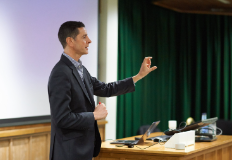Written by Eleanor Bale
On Thursday 27th April DataCDT held a Presentation Training Workshop – taught by Westbourne Consulting – for all of its current PhD students. Doctoral researcher Eleanor Bale attended, her thoughts on the training workshop are below. If you would also like to receive regular, practical, high-quality training during your PhD, you can apply for a position with DataCDT via: https://datacdt.org/entry-criteria-applying/

—–
I’ve always found presenting to be quite a stressful experience, the pressure of ensuring that I am able to present my ideas cohesively and coherently whilst appearing confident, has felt quite overwhelming. However, I am aware of the importance of being able to discuss and explain my ideas to a broad audience, and so, I approached the DataCDT presentation training workshop with slight apprehension!

Despite my initial hesitation, the presentation workshop was relaxed; presenting was far easier and smoother than I had anticipated. The conversational and constructive discussion which followed included great advice from Simon, the workshop leader, who was able to provide precise and informative feedback which was tailored specifically to each presentation.
As well as delivering a presentation, we were tasked with expressing our own thoughts on both our own presentation and others’, encouraging us to self-reflect and consider the crucial elements of a presentation.
By giving my own presentation I learnt the value of using images and graphics, as this increases the quality of presentation slides – and it also removes the option of reading straight from slides for a whole presentation, which can cause audiences to disengage from a speaker.

Additionally, we discussed the topic of presentation notes. Simon suggested using one single page with a small rectangular box for each slide with a sketch of the slide and the keywords related to that slide, allowing for a quick reminder when glancing at the notes. This prevents the urge in a presentation to avoid eye contact with the audience by just reading notes. This is the piece of advice that I found the most useful from the session, but additional advice included:
- Include the slide number in these notes so that you can easily return to slides during Q&A.
- Use the presenter view when presenting so that you are always aware of what slide is next.
- Slides should always be symmetrical with as little text as possible – the more text, the more difficult for the listener to follow, as they have multiple things to focus on.
I took away a large amount of advice and information from the day – especially with having more confidence in my public speaking abilities, and knowledge of how to simplify my slides, but also to never be afraid of taking notes, or looking at them during the presentation. I’m looking to present some of my ideas following the writing up of my first paper, and I will be using these techniques in the run up as practice – all of this will hopefully improve my confidence in presenting my ideas. I found the training an incredibly useful experience and I’ll be trying to implement all the advice given in the near future.